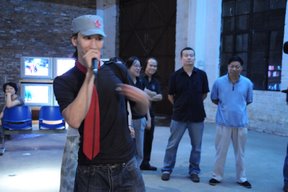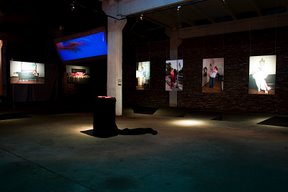CantoCore and Free On Bard
This exhibition is a collaboration with The Garage Biennale, The Fabricatorz, and Ping Pong Gallery, Guangzhou China.
Cantocore and Free On Board is a two-part project exploring the globalized conditions of contemporary culture, through an exchange between artists from the San Francisco Bay Area and Guangzhou, China.
The collaboration takes its inspiration and its name, "Cantocore," from the rapid economic, social, and cultural changes currently taking place in Canton province. Hip Hop is thriving, heavy metal music is blasting, and the art market is booming. Over the last 20 years, cities such as Guangzhou, the capital of Canton, have changed from having a uniquely Chinese culture into global cities influenced and informed by diverse forms of representation. During the same period, Chinese artists also have exerted a growing influence on culture across the globe - and perhaps nowhere more than here on the Pacific rim of California, where Chinese Americans have played a central role since its inception. Art and culture is no longer defined by merely national boundaries - if it ever was - and yet cultural differences persist, providing productive tensions, rich with critical and creative possibilities.
Cantocore works to explore these globalized conditions of contemporary culture and the possibilities they present, by cultivating the dialogue specifically between the Bay Area and Guangzhou. Artists involved in the project include, among others, Americans with roots in China, Chinese who have come to study and work in San Francisco, and Americans who have emigrated to China. The first installment of the project, titled Cantocore: Import / Export, took place in September 2008 at the Ping Pong Space in Guangzhou. Cantocore: Free On Board provides the follow-up response.
What common concerns inform these artists work? How does their art nevertheless read differently across the globe? How do the histories and environments of each city inform the aesthetics of the work produced and presented there; and how does the work transcend its geographic origins, drawing aesthetic and conceptual influence from elsewhere?
About the exhibition:
The exhibition opens with Huang Xiaopeng's What Does "Globalization" Means To You? a wall text piece that stretches the entire hallway. A billboard contained indoors, the piece is too big to digest while remaining still. The viewer must walk back and forth, tracing the text with his body instead of his eye. The result of translating "globalism" from English to Chinese to English is "thanks to the expansion of the empire economic and culture exchanges become possible to the maximum extent and previously isolated civilizations become linked". A very appropriate opening for Cantocore.
Misako Inaoka's Zen Garden (2009) incorporates many layers of context. Inaoka, born in Kyoto and based in San Francisco, constructed the piece in Guangzhou where, according to the press release, "she discovered a market selling fabricated rocks, grass, and fruit". Two of the rocks are equipped with wheels and corresponding remote controls allowing visitors to create their own design using a traditionally inanimate object as a vehicle for their inspiration. Inaoka comments not only on the commercialization of the Zen in the US (think mini Zen garden for an office desk) but possibly China's commercial Zen. The remote-control cars beneath the fabricated rocks are most certainly made in China. A subtle, but poignant detail of Zen Garden hangs precariously with a charger plugged into two adaptors and subsequently into a transformer.
In his single channel video One Day (2007), Zhou Tao documents his life in a Chinese mall. The artist transposes his daily, private activities into the public life of the mall, where he shaves, watches TV, and sleeps. A comment on the commodification of culture, but also the transposition and eerie familiarity to a US mall holds up an interesting mirror to both Chinese and American consumers. Many artists, from Marina Ambrovic to Joseph Beuys, have explored living in gallery spaces, or invite the public to have a moment of 'living' in a gallery like Rirkrit Tiravanija cooking for gallery visitors. Tao's living in a public space, however, harps not only on a collective fascination, but also a collective reality shared throughout the world.
Other work includes Jon Phillips' installation of an LED screen on scaffolding streaming facts about China from both the English and Chinese Wikipedia pages. Kathrine Worel photographs Americans in Buddhist poses trapped in everyday locations: the most arresting depicts a tank-top, baseball cap clad man laying horizontally across a couch complete with empty beer cans on the floor. Fang Lu contributes a three channel video piece in which he has hired performers to reenact news stories culled from recent Chinese press. David Johnson presents a California-shaped crate complete with packing peanuts, literally referencing the exportation of culture.
Through both the layering of cultural exchange in the work, and the actual practice of shipping work from Guangzhou to San Francisco, Cantocore explores the subtleties in an interesting moment in the history of globalization. Will the world continue growing smaller and cultures more alike? Or will the world regress to more sequestered, local version of itself because of the contracting economic markets?
Also on view at Mission 17: imPOSSIBLE!: 8 Chinese Artists Engage Absurdity, a collaborative exhibition with The San Francisco Arts Commission Gallery.
--Katie Farrell











